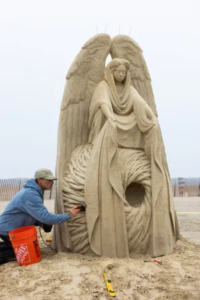“Earthrise” 1968

You’ve no doubt seen this photo before. It was recently included in a New York Times feature titled “25 Photos That Defined the Modern Age.” Here’s the copy that went along with it:
On Christmas Eve 1968, aboard Apollo 8 during its pioneering orbit of the moon, William A. Anders photographed the Earth “rising” above the lunar horizon. The picture was the first of its kind – and it was also unplanned. Anders, the youngest of the three astronauts on the spacecraft, had been tasked with taking photographs of the moon’s craters, mountains and other geological features. He spontaneously decided, however, to include Earth in the frame when he noticed how beautiful it was. “Here was this orb looking like a Christmas tree ornament, very fragile,” Anders would recall in a NASA oral history. “And yet it was our home.” His first shot was in black and white. For the next, he switched to color, which emphasized the contrast between the moon’s gray surface and the planet’s blue-green vibrancy. “Earthrise” was the first image most of humanity saw of the planet we live on, a nature photo like none before it and a reminder of how small our world really is, in comparison with the rest of the universe.…”










